ChessBase Magazine 164 – A day well spent!
 Review by Sagar Shah
Review by Sagar Shah
In part one of his review of ChessBase Magazine 164 the author told us how on the 1st of February 2015 he had sat down to work on all three phases of the game – opening, middlegame or the endgame – with complete dedication, using the material contained in ChessBase Magazine 164. He described how in spite of being fairly saturated by the subject he followed the World Championship reports and the new annotations by Mihail Marin, Parimarjan Negi, Evgenvy Postny, Michael Krasenkow and Rustam Kasimdzhanov, plus the views views of the Anand and Carlsen seconds, Radoslav Wojtaszek and Peter Heine Nielsen.
Sagar then went through the CBM reporting of the Qatar Masters 2014, which he found "excellent". He was especially impressed by the commentary submitted by GM Yu Yangyi, "who gave a perfect balance of words and variations," allowing the reader to find out what was going through the mind of the tournament winner when he made a specific move. The author then went on to study the openings surveys of Robert Ris (Queen’s Gambit Accepted D20, 1.d4 d5 2.c4 dxc4 3.e4 b5 4.a4 c6 5.axb5 cxb5 6.Nc3 a6 7.Nxb5 axb5 8.Rxa8 Bb7), Martin Breutigam (King’s Indian E60 1.d4 Nf6 2.c4 g6 3.Nf3 Bg7 4.e3) and Alexey Kuzmin (1.e4 c5 2.Nf3 e6 3.d4 cxd4 4.Nxd4 a6 5.c4 Nf6 6.Nc3 Bb4 7.Qd3). They are listed with nine other surveys at the bottom of this page. We continue this review with opening videos that are included in ChessBase Magazine 164.
Opening videos
There are three opening videos in this CBM: Adrian Mikhalchishin on the Sozin Variation of Najdorf, Karsten Mueller on the Vienna (e4 e5 Nc3) and Nicholas Pert on the Bf4 line of the Benoni. I looked at the 23 minutes video by Pert and the new idea that he proposes is very interesting.
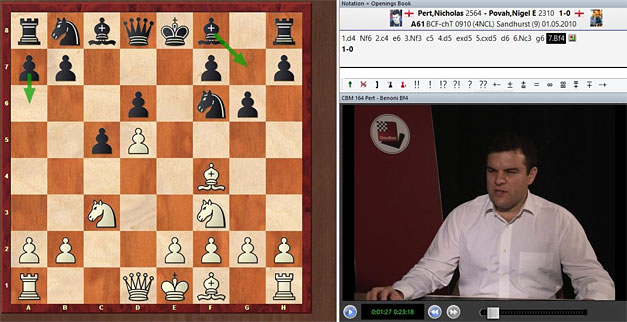
In this interesting line of the Benoni Pert deals with both the black moves 7…a6 and 7…Bg7 in quite some detail
Opening Traps by Rainer Knaak

Rainer Knaak takes you through six opening traps from games that happened in the last two months. The traps were not simple and at times even very deep. I learnt quite a lot from these six examples. The above position was one of my favorites from this section. It is White to play what would you do? After you have tried solving it look at the answer and also the depth of the annotations.

[Event "AUT-chT 1415"] [Site "Austria"] [Date "2014.11.21"] [Round "2.1"] [White "Schwabeneder, Florian"] [Black "Hausner, Ivan"] [Result "1-0"] [ECO "B84"] [WhiteElo "2350"] [BlackElo "2335"] [Annotator "Knaak,Rainer"] [PlyCount "91"] [EventDate "2014.11.20"] [EventType "tourn"] [EventRounds "11"] [EventCountry "AUT"] [Source "ChessBase"] [SourceDate "2015.01.15"] [WhiteTeam "Grieskirchen/Schallerbach"] [BlackTeam "Mayrhofen/Zell/Zillertal"] [WhiteTeamCountry "AUT"] [BlackTeamCountry "AUT"] 1. e4 c5 2. Nf3 d6 3. d4 cxd4 4. Nxd4 Nf6 5. Nc3 a6 6. Be2 e6 7. O-O Qc7 8. f4 Be7 9. Be3 {Black now has 4 plausible continuations, but one of them is bad.} b5 $2 {Too soon.} (9... O-O) (9... Nc6) (9... Nbd7) 10. e5 $1 ({In practice} 10. Bf3 {is also very successful, but only because} Bb7 11. e5 dxe5 12. Bxb7 exd4 $142 $1 ({is usually followed by} 12... Qxb7 $2 13. fxe5 Nfd7 14. Qg4 $1 ( 14. Rxf7 $5 Kxf7 15. Qg4) 14... g6 (14... Nc6 15. Qxg7 $18) 15. Nxe6 $18) 13. Bxa8 dxe3 $13) 10... dxe5 11. fxe5 Qxe5 (11... Nfd7 12. Bf3 Bb7 (12... Ra7 13. Nf5 $18) 13. Bxb7 Qxb7 {leads to the variation above.} 14. Qg4 $18) 12. Bf4 Qc5 13. Bf3 {Black now loses an exchange; but White has a long way to go before victory.} e5 $6 (13... Nd5 $2 14. Nxd5 exd5 15. b4 Qc4 16. Re1 $18) (13... Qa7 $5 14. Kh1 b4 (14... O-O 15. Be3 $1 Bc5 16. Bxa8 Qxa8 17. Nxe6 Bxe6 18. Bxc5 $18) 15. Ncb5 axb5 16. Nxb5 Qa5 17. Nc7+ Kf8 18. Nxa8 e5 19. Be3 Nbd7 20. a3 bxa3 21. Nb6 Nxb6 22. Rxa3 Na4 23. Ra1 Bd7 24. b3 $16) (13... O-O $5 14. Bxa8 e5 15. Bxe5 Qxe5 16. Kh1 b4 17. Nf3 Qc7 18. Nd5 Nxd5 19. Bxd5 $16) 14. Be3 exd4 15. Bxd4 (15. Qxd4 $1 Qc7 16. Bxa8 $18) 15... Qc7 16. Bxa8 O-O $18 {/+/-} 17. Qf3 Be6 18. Ne4 Nbd7 19. Nxf6+ Nxf6 20. Be4 Ng4 21. g3 Rd8 22. c3 Nf6 23. Bf5 Bd5 24. Qe3 Bb7 25. Rae1 Qc6 26. Qf3 Qxf3 27. Rxf3 Bxf3 28. Rxe7 b4 29. Ra7 bxc3 30. bxc3 Be2 31. Bc2 Bc4 32. Bb3 Bxb3 33. axb3 Ne4 34. Rxa6 h5 35. b4 Rc8 36. Ra3 Nd6 37. Ra5 Ne4 38. Ra3 Nd6 39. Kf2 Nb5 40. Rb3 Re8 41. Be3 Rc8 42. Bc5 Ra8 43. c4 Ra2+ 44. Ke3 Na3 45. Kd3 Nc2 46. b5 1-0
Move by Move – Simon Williams
The move by move series of CBM was conducted by Daniel King to date. In this issue he has been replaced by his country mate Simon Williams.

Simon Williams takes us through game Kramnik – Giri from the Qatar Masters 2014
The game is in the interactive Fritztrainer format, which means that we have to make a move on the board when a question is asked. I really like this form of training, because when you make a move it gives you a sense of responsibility. Usually you will not make a move lightly as you do not want it to be incorrect. At the same time you cannot go ahead by just fast forwarding the video.
This interactive training is an excellent way to improve. I had seen the game in quite some depth and also annotated it for the ChessBase website, but Simon was able to reveal some new points. He was the official commentator at the Qatar Masters and Kramnik had come to the press room after the game. You can say that after Kramnik, Simon would be the best guy to take us through this game! It took me nearly two hours (listening to the analysis and thinking over his questions) to complete this section. It was certainly most rewarding, and my advice to all of you would be to finish this training in one go. The reason for this is that, if you left it half way and then decided to restart it, you would have to begin right from the first minute because of the interactive interface.
Strategy: The advance of the h-pawn

Dorian Rogozenco covers a lot of positions in which just pushing the h-pawn can have dangerous consequences for the opponent. He shows openings in which this advance is used as well as typical middlegame and endgame structures where this is applicable.
Just as an appetizer you can see how the h-pawn destroyed a World Champion’s position right from the opening.

[Event "URS-chT"] [Site "Moscow"] [Date "1972.??.??"] [Round "?"] [White "Stein, Leonid"] [Black "Smyslov, Vassily"] [Result "1-0"] [ECO "A17"] [WhiteElo "2620"] [BlackElo "2620"] [Annotator "Rogozenco,Dorian"] [PlyCount "69"] [EventDate "1972.03.01"] [EventRounds "9"] [EventCountry "URS"] [Source "ChessBase"] [SourceDate "2015.01.15"] 1. c4 Nf6 2. Nc3 e6 3. Nf3 b6 4. e4 Bb7 5. Qe2 Bb4 6. e5 Ng8 7. d4 d6 8. a3 Bxc3+ 9. bxc3 Ne7 10. h4 Nd7 11. h5 Bxf3 12. Qxf3 dxe5 13. h6 $1 {It certainly makes sense to weaken Black's kingside by advancing the h-pawn further right away.} ({For instance after} 13. Bd3 O-O $11 14. h6 g6 {White cannot take on e5 any longer:} 15. dxe5 $4 (15. O-O Nf5 $5) 15... Nxe5 16. Qf6 Nxd3+ 17. Kf1 Nf5 $19) 13... gxh6 ({After} 13... g6 14. dxe5 $14 {Black cannot take the pawn: } Nxe5 $2 (14... Nf5 $2 15. g4 Nxe5 16. Qe2 $18) (14... c6 $14) 15. Qf6 $18) 14. Bxh6 exd4 15. Bg7 Rg8 16. Rxh7 Nf5 17. Bxd4 $16 {The position is very sharp and chaotic, but with more active pieces and the safer king White's chances are preferable.} c5 18. g4 cxd4 19. gxf5 e5 20. Qd5 Rf8 21. cxd4 Rc8 22. Rd1 Qe7 23. Bg2 Rg8 24. Qb7 Rxc4 25. dxe5 Qxe5+ 26. Kf1 Qb5 27. Kg1 Qc6 28. Qxc6 Rxc6 29. Rh8 Rcg6 30. fxg6 Rxh8 31. Bc6 Rg8 32. Bxd7+ Ke7 33. Bf5 fxg6 34. Rd7+ Kf6 35. Bd3 1-0
Studying the Classics

Dorian Rogozenco also presents a classical game between Steinitz and Von Bardeleben. Personally the first eight minutes of the ten minutes video were not really interesting for me, as I knew the game pretty well. But in the last two minutes Rogozenco showed a wonderful game of the twelve-year-old Spassky with a similar theme to the one Steinitz used against Bardebelen. Now, this is extremely valuable as such things can only be learnt from an experienced coach.
Tactics by Oliver Reeh

Oliver Reeh has two interactive problems for you to solve
in which he guides you through the problems in a video format

In the remaining problems you have to choose the right answer from the box on the right
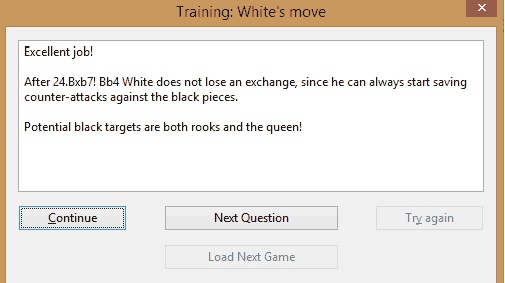
And detailed explanations are given which more than makes up for the lack of video support
I tried solving some of the tactical puzzles and a few were extremely difficult to crack. Reeh poses questions on almost every other move, which makes it a little easy for seasoned players. But what they could do is to think deeply on the first move itself and try to calculate right until the end. If addressed in this way, the puzzles can be challenging even for grandmasters!
Endgame videos by Karsten Mueller
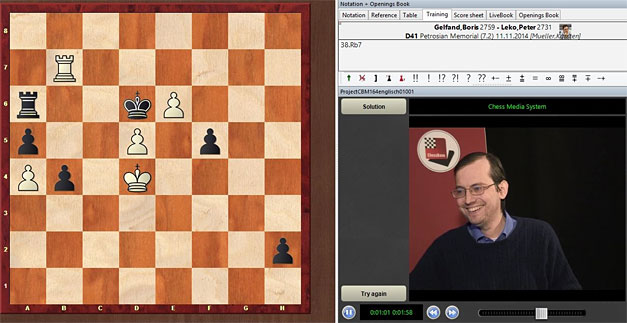
Karsten Mueller, who is currently deemed as one of the leading endgame experts
in the world of chess, has prepared seven videos for you in this CBM
There are two videos in interactive format and five normal ones. Karsten analyses four endgames from the World Championship match. Of particular interest for me was game seven. You might recall the unusual material balance that arose in that game.

Game seven of the match between Carlsen and Anand
Of course I had huge hopes that Karsten Mueller would be able to explain this endgame in detail as it is almost impossible for mortals like us to understand how to play with either colour. But he just spent five minutes on this endgame with some superficial analysis. What I would have expected from him is to show how White can try to win in such an endgame and what is Black’s best defensive setup. He made up for this by showing another endgame between Giri and Kramer in which a similar material balance arose.
CBM Test

Last but not the least, the feature of CBM test is something pretty novel. A click on the above icon loads a random training position set by either, Oliver Reeh, Rogozenco or Mueller. It is quite a nice way to test yourself without really knowing what the theme is.
Conclusion
The hours on that Sunday simply flew for me. I worked for more than ten hours and I must say, it was an extremely enjoyable day training with some of the best grandmasters in the world. Not only were my openings updated and I got new ideas, my middlegame strategy and tactics along with endgame technique were also polished! What more can you ask for?
ChessBase Magazine 164 is made tastefully by GM Rainer Knaak and his team and the hard work put in by each and every contributor is quite apparent. The cost of the magazine is very reasonable which makes it a great “value for money” purchase. I would rather buy a ChessBase Magazine than any other opening DVD because with the CBM I get to train all the phases of the game. So let me take your leave as I have still a few tactical positions of Oliver Reeh left to solve!
All Opening Surveys in CBM 164
 |
Illingworth: Reti Opening A11
1.c4 Nf6 2.g3 c6 3.Bg2 d5 4.Nf3 g6 5.b3 Bg6 6.Bb2 0-0 7.0-0
In the second part of his article on the double fianchetto Max Illingworth looks into the most frequently played moves 7...a5 and 7...Bg4. As he does so, the author demonstrates above all what happens in the early middlegame – what White can make out of his positions which are generally slightly in his favour.
|
 |
Moskalenko: Pirc Defence B09
1.e4 d6 2.d4 Nf6 3.Nc3 g6 4.f4 Bg7 5.Nf3 0-0 6.Bd3 Nc6
In the diagram 7.0-0 is the move played most often, but as Viktor Moskalenko explains Black has absolutely no need to fear the tactical complications after 7...e5 8.fxe5 dxe5 9.d5 Nd4. And in the main variation 7.e5 dxe5 8.fxe5 Black even has two good moves: 8...Nh5 and 8...Ng4.
|
 |
Kuzmin: Sicilian Defence B41
1.e4 c5 2.Nf3 e6 3.d4 cxd4 4.Nxd4 a6 5.c4 Nf6 6.Nc3 Bb4 7.Qd3
The queen move was a strong surprise weapon for Carlsen against Anand, but as Alexey Kuzmin shows in his article, it is more than that. It is difficult for Black to equalise at all and it can be supposed that in the future players will deviate.
|
 |
Postny: Sicilian Defence B48
1.e4 c5 2.Nf3 e6 3.d4 cxd4 4.Nxd4 Nc6 5.Nc3 Qc7 6.Be3 a6 7.Qf3
Instead of 7.Qd2 and 7.Bd3, moves played thousands of time, and other continuations, this time it is 7.Qf3 which is up for debate – a move which only the 11th most frequent. But as Evgeny Postny shows, the move has potential, its main idea consisting of Qg3, because after the exchange of queens White gets a very pleasant endgame.
|
 |
Havasi: French Defence C06
1.e4 e6 2.d4 d5 3.Nd2 Nf6 4.e5 Nfd7 5.Bd3 c5 6.c3 b6
The early exchange of bishops is a tried and trusted manoeuvre in the French. As Gergö Havasi demonstrates, with aggressive play White can build up some pressure, but the closed positions offer Black good chances of getting away with his plan.
|
 |
Marin: French Defence C09
1.e4 e6 2.d4 d5 3.Nd2 c5 4.exd5 exd5 5.Ngf3 Nc6 6.Bb5 (cxd4/Qe7+)
If you play 6...cxd4 or 6...Qe7+ (instead of the main move 6...Bd6), you have to be prepared to exchange queens at an early stage. In his extensive article Mihail Marin refers to many Korchnoi games, but also shows the modern treatment by Vadim Zvjaginsev.
|
 |
Müller: Vienna Game C26
1.e4 e5 2.Nc3
Karsten Müller’s new article is linked to his articles on the King’s Gambit: after 2...Nc6 the transposition is made with 3.f4. However, this time it is principally about 2...Bc5 (3.Nf3) and even more important - 2...Nf6 (3.g3). This way speculative sacrifices are avoided.
|
 |
Ris: Queen’s Gambit Accepted D20
1.d4 d5 2.c4 dxc4 3.e4 b5 4.a4 c6 5.axb5 cxb5 6.Nc3 a6 7.Nxb5 axb5 8.Rxa8 Bb7
The 3...b5 variation is supposed to be made playable with a surprising exchange sacrifice. In his analyses Robert Ris comes to the conclusion that White can obtain a slight advantage, but in practice these positions are far from easy to play.
|
 |
Gormally: Queen’s Gambit Accepted D24
1.d4 d5 2.c4 dxc4 3.Nf3 Nf6 4.Nc3 a6 5.e4 b5 6.e5 Nd5 7.a4
In Part 2 Daniel Gormally turns to the sharp lines in which Black tries to defend his extra pawn. But all these attempts are dubious. Even when the positions which are reached are okay according to the engines, in practice Black is facing grave problems.
|
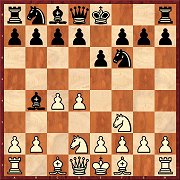 |
Krasenkow: Bogo-Indian E11
1.d4 Nf6 2.c4 e6 3.Nf3 Bb4+ 4.Nbd2
Michal Krasenkow presents his own repertoire against the Bogo-Indian. In the first part he shows above all what he has up his sleeve against the present main variation 4...0-0 5.a3 Be7, namely: 6.b4, which has not been played often so far but which is very venomous.
|
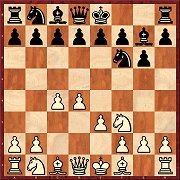 |
Breutigam: King’s Indian E60
1.d4 Nf6 2.c4 g6 3.Nf3 Bg7 4.e3
As long as White has not played Nc3, Black cannot transpose to the Grünfeld Defence. But Martin Breutigam sees more in the setup he is presenting: after transpositions to the Benoni or the King’s Indian the pawn on e3 (instead of e4) also has an advantage: there is no need to defend it.
|
 |
Szabo: King’s Indian E73
1.d4 Nf6 2.c4 g6 3.Nc3 Bg7 4.e4 d6 5.Be2 0-0 6.Bg5 Na6 7.f4 c6
In the Averbakh Variation too, ...Na6 is a common move. White then strengthens his centre with 7.f4. But as Krisztian Szabo shows in his article, Black will then attack it rapidly with ...d5. In the sharp lines a good knowledge of the theory ids advisable.
|
Order ChessBase Magazine 164 here


















 Review by Sagar Shah
Review by Sagar Shah




























